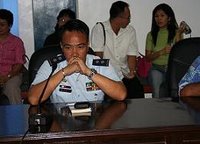Unlike some Ilonggo families who can trace their provincial roots by virtue of an ancestral hacienda or some other old property, my family on my father’s side never owned large tracts of agricultural land or any business establishments in Iloilo. As far as I know, we Mendozas never had a flair for agriculture or a knack for business. When I was a boy, I remember that my father tried to manage a farm that my mother’s family owned in Dumangas, Iloilo but he did not do too well. He also used to operate buses in Negros Occidental but that also did not end well. All my relatives on my father’s side are ordinary-salaried employees and professionals, seamen, nurses, OFWs, teachers, minor government functionaries, etc. Since we are not farmers, we Mendozas to a large extent can be described as “provincial city-folks.” The only real estate property my forebears left behind is an old, dilapidated house along Rizal Street (at the back of the Chinese Temple) at Iloilo City Proper where my father and all his siblings grew up. Although all of my aunts and uncles have now settled in different parts of the province and the country, we Mendozas have always thought of ourselves as "mga taga-Rizal." For this reason, whenever people ask me where in Iloilo City I am from, I usually tell them "I am from Rizal" even though I have never lived there in my entire life.
I suspect that the reason why not a single relative on my father’s side had become a hugely-successful farmer or entrepreneur might be attributed to our genes. Farming and business is simply not in our blood. My paternal grandfather, Raul Mendoza, worked as a harbor pilot in Muelle Loney (Iloilo City’s seaport) before the Second World War, along with five other individuals; Capitan Garriz, Señores Borromeo, Goyena, Martin and Mascunana. I used to think that being a harbor pilot was a lowly job until I learned that harbor pilots today in say, the port of Manila, earn an average of P500,000 a month! This is so because they get a certain percentage of the fees that all ocean-going vessels pay when docking at the pier. I surmise that my grandfather, together with his five partners, must have made a good living out of guiding cargo vessels and ships into the tricky Iloilo River, especially in light of the fact that Muelle Loney during the 1930s was one of the country’s busiest ports and a major hub of the lucrative sugar industry at that time. Even today, old-timers at the Iloilo port still remember my grandfather and some refer to him as “
Agurang” which roughly translated means “respected old one.” Aside from my grandfather, another grand-uncle also worked at Muelle Loney: Tito Valdes, was the general manager of the now-defunct Compania Maritima. Incidentally, Tito Valdes, who married my grandfather’s younger sister, was the brother of Quezon crony and Army Chief of Staff General Basilio Valdes. (
Muelle Loney circa 1920s)

After the war, Lolo Raul was commissioned by Don Fernando “Nanding” Lopez (who would later become Senator and Vice President of the Philippines) to convert a U.S. Navy PT Boat into a yacht (don’t ask me how the Lopezes were able to acquire a PT Boat from the U.S. Navy). Upon its completion, the Lopezes christened the PT Boat-cum-yacht “Miss Iloilo” and retained my grandfather to be their yacht’s “maintenance man.” Incidentally, I once saw the yacht “Miss Iloilo” in the movie “Eskapo” - in the scene where Christopher de Leon (who was playing Geny Lopez) heard over radio that Marcos already declared martial law while cruising aboard the yacht with his family.
Sometime in November 1947, “
Agurang” (my lolo) was asked by Don Nanding Lopez to go to Manila to carry out regular maintenance and check-up operations on “Miss Iloilo.” Upon learning that he was going to Manila, a bosom buddy who owned a private plane offered my Lolo Raul to hitch a ride in his aircraft. His good friend, Captain Jose "Peping" Tinsay, was an “aviator-cum-entrepreneur” who flew his own airplane and engaged in the profitable buy-and-sell business. Captain Peping Tinsay brought bangus, crabs, talaba, and other assorted products from Iloilo to sell to Manila and on his return flights would bring back “scarce” items like canned goods, flour, shoes, etc. to sell in Iloilo City. So on November 22, 1947, the two friends (or two "pilots") left Iloilo airport for the one-hour flight to Manila. Incidentally, Lolo Raul was anxious to return to Iloilo because his wife, my lola Juanita Villanueva-Mendoza, will be celebrating her birthday two days later, on November 24. Unfortunately, the two never reached their destination and their plane crashed in the sea. Their bodies were never recovered.

Since my Lolo Raul died long before I was born, he is a distant and rather abstract figure in my mind. All that I know of him I learned from the sketchy stories and sporadic anecdotes told to me by my father, my aunts, uncles and other relatives and as you can see, I really do not know much about him aside from what I have written here. This is probably the reason why I am particularly interested in Iloilo history – reading history does not only give me a glimpse of the past but more importantly allows me to learn more about my grandfather. It is my hope that someday, another person would surface to shed more light on this most enigmatic of my ancestors, Raul Mendoza.
(Photo of Muelle Loney today)
(Photos are courtesy of the University of Wisconsin Library archives and Dongdong Flores)



